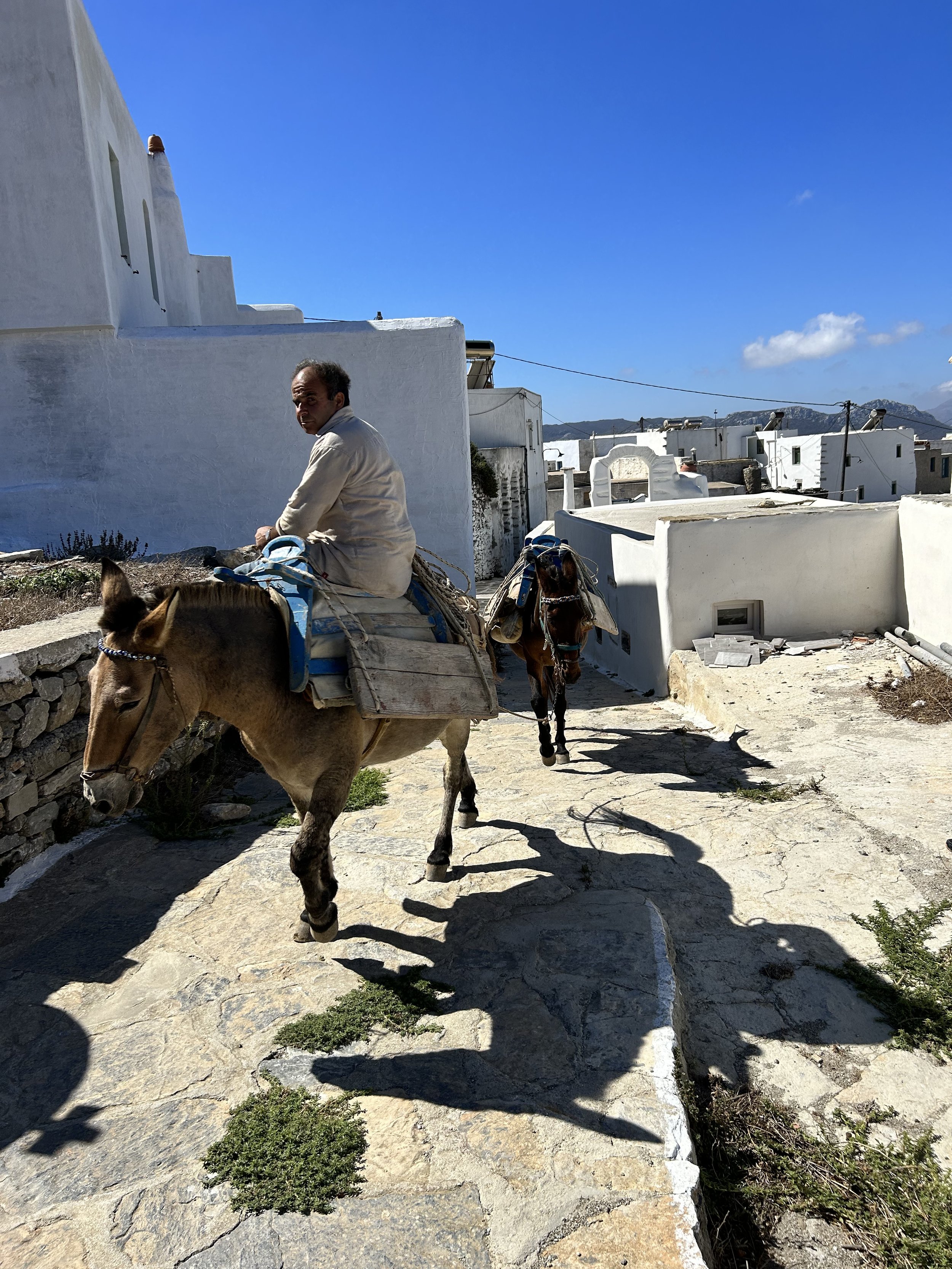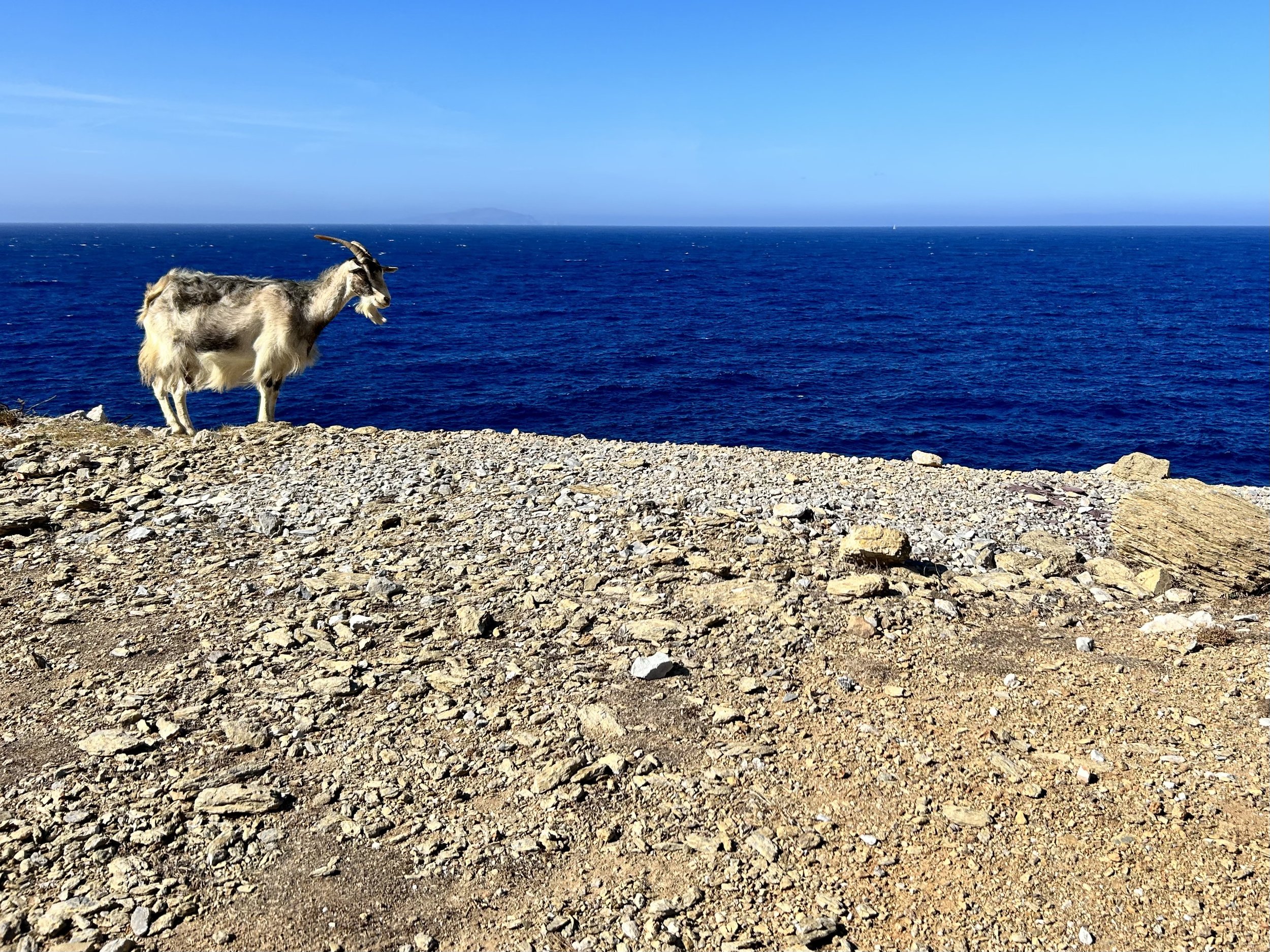Vacation Part 10- Amorgos
The island has several small inlets that pass for harbors. None of them are big enough for a small cruise ship.
If you want to sample the “outback” of Greece, spend a day on the island of Amorgos. Our visit started by catching the first tender going into the town of Katapola. The guide book was specific about traveling the island. You’ve got to have wheels, or a lot of time. We took the advice and popped into a ‘vehicle for hire’ establishment near the landing. The nice lady running the place asked about our experience on the Vespa. The response was kinda like, “Well, there was this one time…” so, not wanting one of her scooters involved in a wreck, she asked about ATVs. We had a little more experience there, but she then said, for ten euros more, we could have her last car for the day. Sold! (We passed several folks on Vespas and ATVs, and by mid afternoon they looked miserable in the relentless wind and sun.) But there was a catch with the car. It needed gas.
For the gear heads, we spent the day driving around a second generation Hyundai i10. It had a massive 1.0 liter Kappa II petrol/LPG engine driving a 5-speed manual. It proved to be a suitable donkey substitute for the island. The dent came with the car.
We hopped in, adjusted the seats and mirrors and took off for the nearest of two gas stations on the island. “It’s just a kilometer up the road,” the lady said. Practically right next door in the mind of the American driver, right? The needle for LPG was pegged at zero. The needle for petrol was also pegged at zero. The “get gas immediately” light was glaring an evil yellow-red, and the “kilometer up the road” was more like two kilometers, up a very steep hill. Frankly, we were kinda surprised we made it, especially after taking a couple of wrong turns. On the bright side, coasting back down to town soapbox derby style was an option.
Having no idea how far we’d be driving, or how much the petrol tank on the i10 would hold, (couldn’t be much, right?) we had the guy at the station fill it up. Afterall, we didn’t want to run low on an island with only two filling stations. When the pump clicked off, the bill came to eighty-eight Euros. What? That’s like ninety some bucks. I thought that sounded like a lot, so I slipped off my shoes and did the math real quick. The pump says thirty seven liters, which roughly converts to nine point something gallons. Okay, that sounds about right for a little car. And a liter of petrol is two point three seven Euros, and there are roughly three point eight liters to the… ugh. That’s like nine bucks a gallon. Okay. Lesson re-learned, grumble-grumble, and off we went on the day’s adventure.
Looking down on the ship and harbor from the road to Chora.
From the gas stop, we continued up, and up some more to Chora, the administrative center of the island. The bustling metropolis is known for a Venetian castle built in 1207 that dominates a fortified rock in the center of town. We pulled in to a public parking area and proceeded to explore the entire village in about twenty minutes. The cafes weren’t open yet and the the houses were boarded up tight. Moving on…
The castle occupies the rock on the left and the former grain milling windmills occupy the island’s central ridge.
We climbed up into the town as far as the Tower of Gavras on the castle rock and then made our way back down to the car. From Chora we drove south and west to the end of the island.
The Amorgos version of a dump truck.
The mountainous areas are used for grazing goats. We were warned to expect them on the roadway.
At the end of the island is Kalotaritissa Beach and a beautiful little anchorage.
The Liveros Bay features the wreck of the Olympia, former Inland. The ship lost power and was blown ashore in 1980.
350 steps up from the gate, The Monastery of Hozoviotissa is built into the cliff face 300 meters above the sea.
After taking in the southwest end of the island, we doubled back to the Monastery of Hozoviotissa on the south east cliffs. The exact timing isn’t known, but it is believed to have been founded around 1088 by the Byzantines. It houses a 7th century icon of the Virgin Mary. The structure was improved by the Venetians in the 13th Century and managed to survive the Ottomans when they arrived in the 16th Century.
The Aegean Sea below Hozoviotissa.
After driving the length of the 500 meter high central ridge, we stopped for a late lunch overlooking Levrossos Beach on the northeast end of the island. If you are in need of a place to stay that isn’t near anything, but still has some desirable amenities, our accidental lunch spot will fill the bill. We could have sat at the Aegialis Hotel pool-side patio cafe for the rest of the week, and then wondered where the time went. The food was nice, the waiter friendly, and the breeze was just right. Keep in mind there is no airport on the island, so a lengthy ferry ride is required to get there.
Looking out from the lobby of the hotel.
Alas, we couldn’t stay forever. We had to make the last tender back to the ship. The remainder of the afternoon was spent driving in the mountains, where we watched the pileus clouds, and dodged the odd goat in the roadway.











